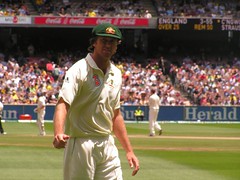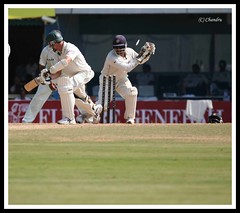How to adjust your game to wet conditions (part 1: batting)
Being English, I'm used to playing cricket in most conditions. One of the worst is the wet and overcast day.
It's harder work for everyone. Cricket is much more fun when the rain stays away.
But let's say it's been raining before your game. The outfield is wet but playable, the light is poor and there is a risk of showers throughout.
Bowlers - Planning your Spell
Thought I might write down a few thoughts regarding some basic guidelines for bowlers who are starting to think about developing bowling plans.
Firstly, bowlers should always remember: YOU START THE PROCESS! this means, while a batsman may arrive at the crease with a plan, and he may even have some idea about what he is going to try to do to you as you are running in, he must ultimately RESPOND to the delivery you produce. This knowledge should encourage you to select each ball carefully but with confidence.
Are you ashamed of your occasional bowling?
The Third XI captain (Sundays) of my old club side was called Dave. He was a large man in his forties without pretention. He loved beer, cricket and Brighton and Hove Albion FC.
He called himself a batsman, but his real talent was his 'occasional bowling', which caused chaos.
Better batting is built on bulletproof concentration
I can't seem to get the South African first Test recovery out of my head. Most comments have been negative: That old fashioned defensive cricket does no good in this big hitting, big money world.
But batting out two full days for a draw requires almost superhuman concentration.
What South Africa's epic rearguard defence can teach your club team
Test cricket doesn't throw up a lot of old fashioned 'bat out for the draw' situations these days, but it's something club cricketers face with regularity.
Your team might only need to last 50 or so overs to rescue a draw, imagine how hard it would be to see off 160. The South African second innings in the first Test against England was an education in how to save the game.
The new facts of club cricket in a Twenty20 world
The IPL is here. Cricket is big money. It's a new world and it’s time we as club cricketers responded to the challenge.
Modern cricket is built on excitement: Power, speed, athleticism and light speed tactical thinking. The whole game is changing thanks to the 20 over format.
Whatever length game you play it's time to consider some new ways of playing.
An introduction to playing better cricket
After several hundred posts I thought it was time you got an introduction. Or, more specifically; Some of the ideas and people behind the practical tips on this site that make you a better player. If you understand these pillars, you understand the system I use and that's essential to your success.
How to win more evening cricket matches

 photo credit: Rick212
photo credit: Rick212It's quite something to think that club cricketers have been playing the shortest version of the game since the first after work matches in the 1920s.
And the IPL thought Twenty20 was a new idea.
Generations of club players have grown up in the format that takes a couple of hours. In recent times the top players have shown the club game how it is done. What can we learn from them, and what should be cast aside when trying to win our local competitions?
How to make sure your club cricket team has a Shane Warne or Glen McGrath

 photo credit: thribble
photo credit: thribbleHas your side ever badly needed a wicket to win turn a game back your way?
For many years Warne and McGrath the 'turn to' men for Australia. In times of trouble all Ricky Ponting had to do was toss the ball to one of them and let chaos ensue. Between them they took over 2000 International wickets.


